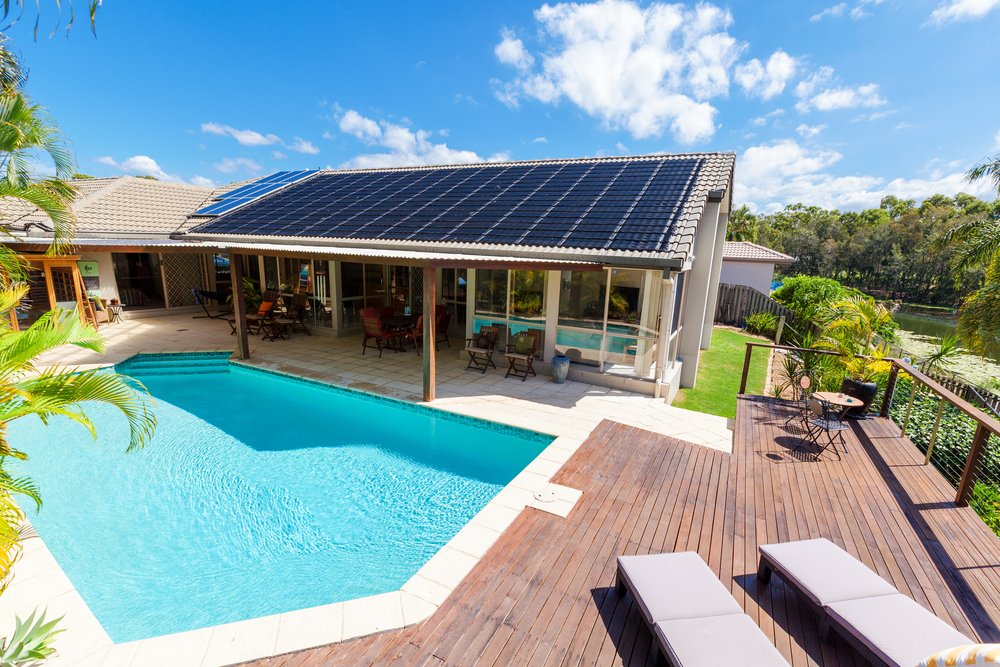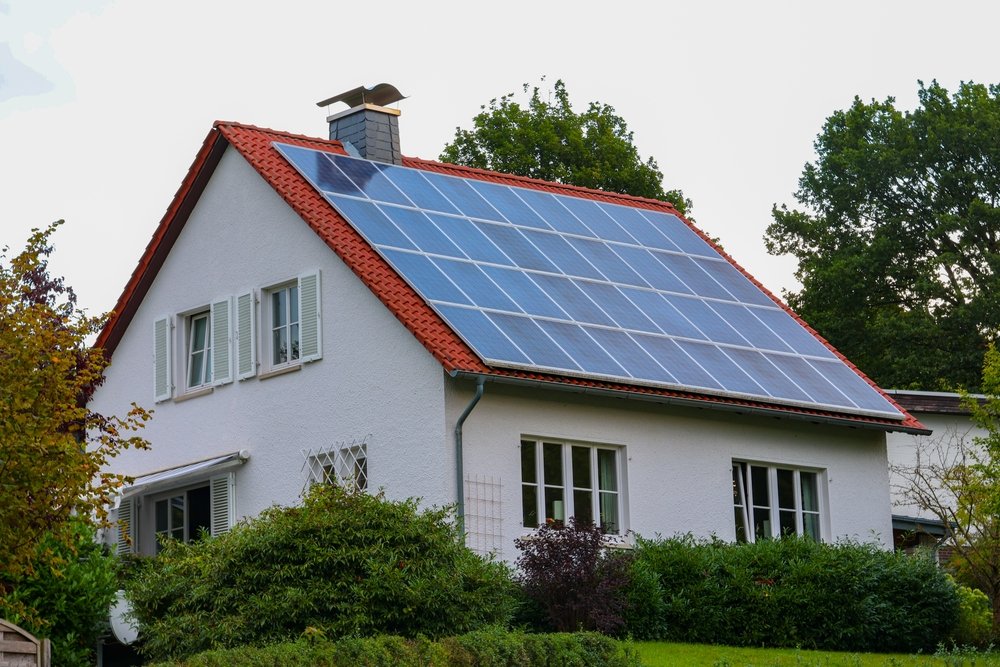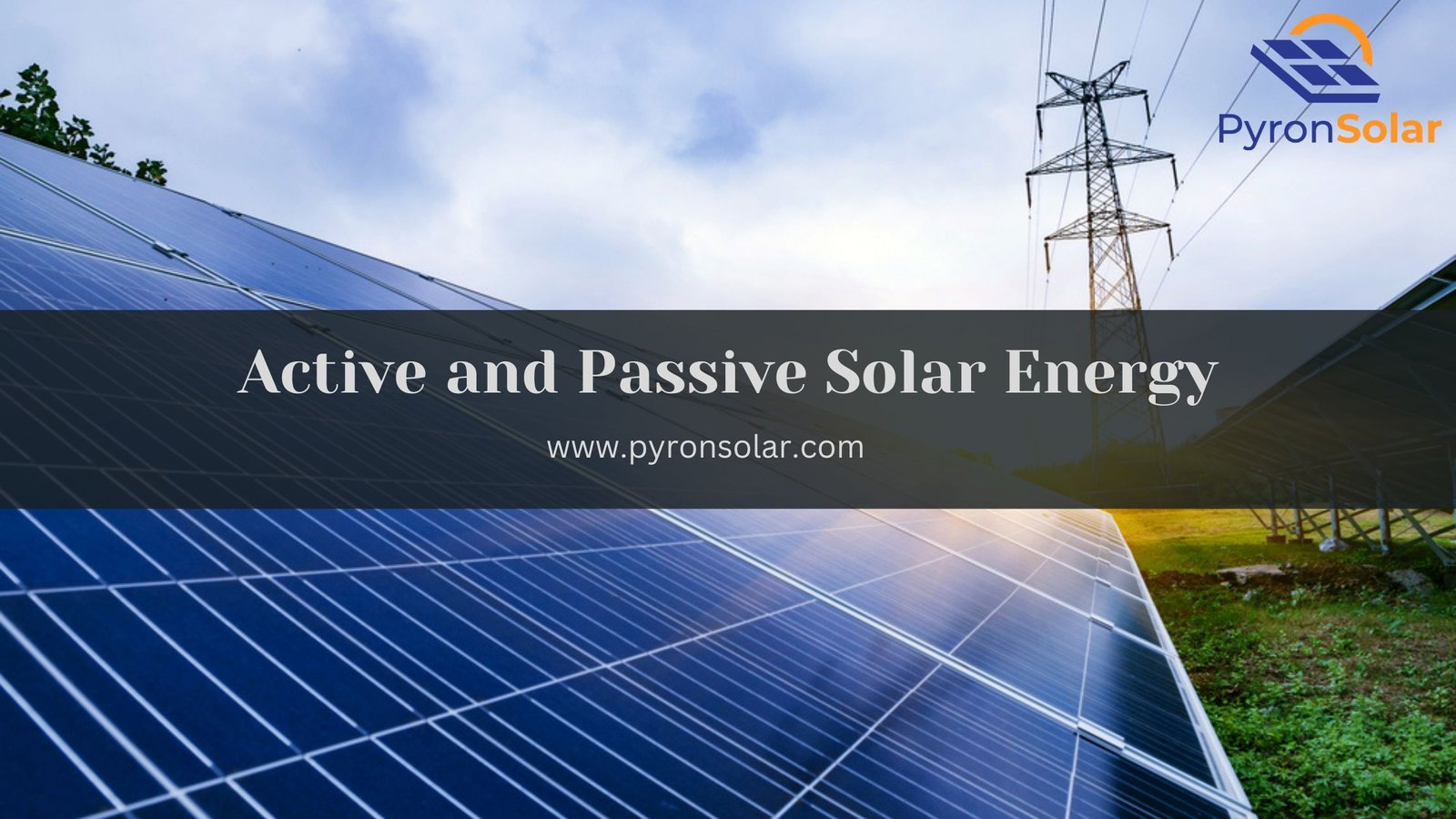Solar energy is a renewable eco-friendly energy harnessed from sunlight to generate electricity or heat, using components like solar panels or solar collectors. It is a sustainable and best environmentally friendly alternative to the traditional fossil fuels. In contrast to the fossil fuels that deplete over some time, then the sun’s radiation is available for billions of years, and its energy can be extracted and used for long-term, without producing any greenhouse gas emissions to maintain a healthy environment.
The power can be extracted in two forms namely Active and Passive solar energy. Interestingly, the definition of passive solar energy systems is simple as it uses the natural heat or light directly from the sun, rather than using mechanical devices like the Active solar energy system. Rather, it relies on the architectural design elements of a building.
Examples of Active solar energy systems include Photovoltaic Solar Panels, Solar water heaters, and Concentrated Solar Power systems. Conversely, to define the Passive Solar energy system we can include examples of houses with larger windows in south-facing, overhanging roofs, stone floors, and concrete walls.

Both Active and passive solar energy systems possess their advantages and disadvantages, by having a majority of differences. Also, it would be intriguing to determine does Active Solar Energy maintains better features than Passive ones or not by knowing how it works in detail.
Moreover, you need to know the government incentives provided that make solar energy affordable for every individual. By the time you complete reading this article, you will have a clear understanding of which system to prefer for your house between Active and passive solar ones. Before knowing active and passive solar energy, you should also know what solar energy is.
Active Solar Energy System
Active Solar Energy is defined as using Mechanical equipment to trap sunlight and convert it to electricity. The captured electricity is usable for electrical devices like fans, water pumps, etc. Also, in the other home appliances and heat fluids using flat-plate PV panels.
The working principle of Active solar systems follows two simple design types namely Thermal and Photovoltaic.
1. Thermal Systems:
By using thermal systems, the solar energy is harnessed using a solar collector during the day and converted to heat. Further, the heated fluid is fed through a circulation pump into the heat exchanger, which transfers the heat from fluid to water in a storage tank.
Finally, the hot water is preserved in a storage tank for future usage.
When compared to the Air Heating system, the process is similar with the only difference of using Air Ducts and a fan to circulate the heated air to provide warmth in the living space.
2. Photovoltaic Systems:
In a Photovoltaic system, sunlight strikes the roof of solar panels by containing an arrangement of photovoltaic cells made of silicon. A Photovoltaic effect is created by allowing a flow of electricity as loose electrons strike the surface. Moreover, Solar panel is layered with positive and negative charges. Phosphorus is used in the top layer and is negatively charged, and Boron in the bottom layer produces charge.
An Inverter converts the DC power generated by the solar panels into AC power to run the appliances in the home and business areas.
The solar charge controllers act as a core device. It regulates the charging process while using batteries to store additional solar energy. Primarily, the charge controllers prevent overcharging and damage to your battery.
Advantages of Active Solar Energy System
There are numerous advantages of installing an Active solar energy system, which is the most promising sustainable and environmentally friendly energy source:
- Reduce your electricity bills: One of the core benefits of Active solar energy systems is they can help you save money on electricity bills by allowing you to use free hot water or electricity. The amount of money you save depends upon the area of your residence.
- Less operating costs: Compared to other energy sources, the maintenance and operating costs are low.
- Grid and Load Support: Active solar systems can effectively contribute to load support and Grid stability, by storing excess energy for future use integrated with energy storage technologies.
- Scalability: The solar energy system can be installed on a small scale for individual homes to a larger scale for commercial purposes.
- Technological advancements: The ongoing research and development in the active solar energy system strives to improve efficiency and reduce costs.
Disadvantages of Active Solar Energy System
While there are numerous benefits, you need to know about certain disadvantages of Active Solar Energy systems as well. Understanding these drawbacks helps you to make a clear plan before making any investment:
- Higher Initial Investment: Typically, an Active solar energy system installation costs for a residential house range from $10,000 to $30,000.
- Larger space requirement: You need to have a large space on the roof to install active solar system panels by ensuring that there isn’t any shade from trees or buildings nearby.
- Weather Dependency: The active solar system is highly efficient in the presence of sunlight. In other words, during cloudy or nighttime the performance of solar systems is relatively low.
- Environmental impact: The manufacturing process involves many hazardous materials and harmful chemicals that can have a severe impact on the environment.
- Energy Conversion: You cannot expect a 100% conversion process to obtain heat or electrical energy by trapping the sun’s radiation as the improvement of solar technologies is an ongoing process of research and development.
Passive Solar System
A passive Solar System can be defined as a building design that uses natural elements like sunlight to heat a building without using any mechanical or electrical equipment. The working process can be explained with the three different types of systems:
Direct gain: The sunlight enters the windows using a direct gain system by using thermal mass materials like concrete or tile floors, due to which the materials are heated and stored in the captured heat. When the temperature drops in the evening, the heat that is stored is released back into the interior space of the house to provide warmth, due to which the additional heating process is reduced during the day and night.
Indirect gain (Trombe Wall): A concrete or Trombe wall with 8 to 16-inch thickness is constructed behind the south-facing windows with dark-colored materials and vertical glass of single or double layer. When the sunlight enters through the window and strikes the thermal mass elements, the heat is captured and gradually released into the building’s space by moderating the indoor temperature. In contrast to the direct gain, this system utilizes the mass of the wall as the heat storage medium to release heat consistently.
Isolated gains (Sunspaces): The passive solar system design of Isolated gains constructs a separate sunspace built with larger south-facing windows or glass to enhance solar exposure. The sunspace provides auxiliary heat by capturing solar energy and stores heat using concrete floors or water barrels. Finally, the heat is circulated from the sunspace into the living area using controlled mechanisms like vents, fans, doors, and shades when the sunlight drops.
Advantages of Passive Solar System
By planning proper architecture for your residential and commercial buildings, you can experience many advantages of a passive solar system:
- Energy Efficient system: By utilizing abundant sunlight which is the evergreen renewable source of energy, the passive solar solar system makes it more efficient by following the simple auxiliary heating form. As a result, the dependence on fossil fuels is reduced.
- Save Your Budget: By reducing the requirements for mechanical or electrical components, you will be able to save energy bills for a lifetime and plan your budget accordingly. The passive solar systems can be incorporated into buildings with a low initial cost when compared to the active solar energy systems.
- Less Maintenance: The components of passive solar energy have a few moving parts and it require less maintenance resulting in reliability and longevity.
- Design Features: Starting from residential homes to commercial buildings, the passive solar system possesses one of the main features incorporating various designs into different types of buildings by matching its functionality.
- Comfortable indoor temperatures: The thermal mass materials and proper insulation system can stabilize indoor temperature as well as minimize the fluctuations in temperature, thereby providing a more comfortable living space.
Disadvantages of Passive Solar System
Certain disadvantages of the Passive Solar System make individuals prefer the active system which includes:
- Highly dependent on climate: In certain regions where sunlight is limited or cloudy regions, the passive solar system is highly dependent on climate and the heating process cannot be performed effectively.
- Larger space requirements: Though the initial costs are lower compared to the active system, a larger space requirement fulfills the criteria for the passive solar system to accommodate features like south-facing windows, thermal mass materials, or sunspaces.
- Complicated Designs: In contrast to conventional building designs, passive solar systems make the designing process complicated for buildings by carefully considering some important factors like building position, window placement, thermal mass selection, and many more.
- Building appearance: The installation of passive solar systems can spoil the design and make the appearance of the building look awkward. It is because the architectural design of the building is limited by ensuring to avoid the shade of tall trees and high climbing shrubs that block the sunlight entering the home.
- Storage Limitations: Compared to the active system, the storage for passive solar energy systems is less efficient and sets certain limitations, which require additional technologies like the deep battery cycle, to reserve energy in the chemical form. Mainly the energy stored in passive solar buildings by using heat-absorbent materials like concrete, wood, and water can be lost easily through the process of conduction, convection, and radiation.
{Video Credit- Allrounder}
Difference between Active and Passive Solar Energy Systems
Certain differences between Active and Passive Solar Energy Systems each having its advantages and disadvantages, which can be differentiated according to various factors such as:
- Cost: The Active Solar energy system has a higher initial cost because it requires mechanical and electrical components. Contrarily, Passive Solar energy is less expensive as it uses simple building design and minimum technology.
- Ease of Application: The passive solar system is easier to install by integrating into the building design, unlike the active system which requires a complex setup with professional expertise for installation.
- Equipment used: Compared to the architectural design elements and natural process of the passive solar system, the equipment used in the Active system includes solar panels, collectors, pumps, and storage units.
- Methods: The active solar energy system uses photovoltaic cells for electricity generation and thermal systems for heating water or air. In Contrast, the passive energy system relies on, building materials and traditional methods like windows, sunlight, and thermal mass materials to collect and distribute solar energy and the sun’s energy.
- Maintenance: Generally, low maintenance is required for Passive solar energy systems on occasional periods for cleaning and small alterations. In the case of the Active energy system, you have to plan for frequent maintenance as it involves components like pumps, fans, panels, and several others.
It would be intriguing to experience the combination of Active and Passive solar energy systems. By integrating the photovoltaic panels with planned architecture that includes strategically designed windows and thermal mass elements, both the electricity and heat generation processes will be carried out smoothly, but careful planning and proper design are required.
Also, there are several benefits of combining both these system’s strengths which include:
- Cost Effective solutions
- Flexibility to adapt to different weather conditions
- Optimized efficiency
- Enhanced Energy storage
- Increased efficiency
Is Active Solar Energy better than Passive Solar Energy?
If you want to determine which is better in the comparison of Active vs Passive Solar Energy systems, it purely depends upon the specific requirements and priorities.
To make it precise, the Active solar energy system is more beneficial compared to the passive ones, if your prime goal is to generate electricity. This is because the photovoltaic process supports an Active system due to the following reasons:
- Sunlight is converted directly into electricity with higher efficiency using solar panels. Though the PV system has higher initial costs and requires more maintenance, ultimately you would benefit from it in the long run.
- You can have greater control over energy production, but only during sunny days.
- The sun’s energy collection process is greater in active solar energy systems to generate electricity.
Contrarily, when you prefer the thermal process to generate heat for water or air spaces, then a passive solar energy system is the clear winner with its maximum ability of heat collection due to these causes:
- The lower upfront costs of installing windows in the south direction enable easier collection of heat in the passive solar energy system.
- The energy system doesn’t have any severe impact on the environment as it doesn’t use any harmful chemicals or materials in the manufacturing process.
- The proper design of your house does not require more mechanical or electrical components to generate heat.
The main disadvantage of the passive Solar Energy system is that it cannot generate more electricity and is not effective in the long run when compared to the Active system.
Are there any incentives for installing active or passive solar energy systems?
Yes, there are several incentives offered by the government for installing active or passive solar energy systems. You need to be aware that the incentives change regularly and it is mandatory to check based on your location levels before making any plans.
The US government offers a 26% tax credit for installing both active and passive in 2023 and 2024. It is expected that the percentage might gradually decrease in the subsequent years.
Moreover, by gaining Renewable energy certificates (RECs), you can generate excess electricity which can be sold or used for your energy consumption.
Also, the Net metering policies allow you to sell excess electricity, thereby reducing electricity bills.
The Department of Energy (DOE) provides various loan programs to provide lower interest rates and long-term loans, that assist individuals of middle-class and upper-middle-class status to afford solar energy installation for residential and commercial purposes.
What is a Passive Solar House?

As discussed earlier, a passive solar house traps heat as the sun shines through the south-facing windows without relying on mechanical or electrical devices. It is a sustainable approach you should prefer if you’re aiming to create a comfortable and energy-efficient environment.
Typically, a passive solar home should include some of these basic elements namely:
- Well-ventilated windows: Avoid any shading or obstacles by facing 30 degrees exactly south to collect more heat.
- Thermal Mass elements: Includes concrete, brick, stones, or tiles.
- Distribution mechanism: Heat should be collected and transferred to different areas of the house by following the methods of conduction, convection, and radiation.
- Proper roofing strategies: If the roof overhangs are properly shaped, they can provide shade to the south window vertically during summer as well as ensure to capture of heat energy.
There are numerous benefits of owning a passive solar home, out of which a few are listed below in brief:
- Enhanced Indoor Air Quality: The best ventilation system installed maintains humidity inside the home within a comfort range of 30 to 60%.
- Reduced electricity bills: Your electricity bill amount can be saved without relying on current from any external sources.
- Coolness: The passive houses in the United States witness more coolness by ensuring the combination of insulation and thermal mass effectively.
- Low maintenance: Passive solar houses require less maintenance compared to the standard systems
- Increased Property Value: Potential buyers find passive solar houses more attractive and convenient to satisfy their needs at the best price. If you’re planning to resell such houses, then you can earn considerable profit.
- Boosted Natural Light: By strategically constructing windows with a proper plan, you can experience natural light entering your house during the day, boosting your house with brightness and positive vibes.
Ray is an avid reader and writer with over 25 years of experience serving various domestic and multinational private and public energy companies in the USA.

